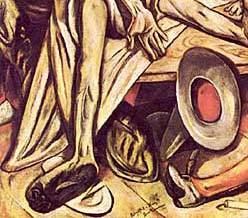Year 1918–1919 Period Expressionism Genre History painting | Artist Max Beckmann Created 1919 Medium Oil on canvas | |
 | ||
Location Kunstsammlung Nordrhein-Westfalen, Düsseldorf Dimensions 133 cm × 153 cm (52 3⁄8 in × 60 1⁄4 in) Similar The Swing, Spring, The Art of Painting, Dancing bar in Baden‑Baden, Family Picture | ||
The Night is a 20th-century painting by German artist Max Beckmann, created between the years of 1918 and 1919. It is an icon of the post-World War I movement, Neue Sachlichkeit, or New Objectivity. It is an oil painting on canvas, located at the Kunstsammlung Nordrhein-Westfalen, Düsseldorf.
Contents
Interpretation
Three men appear to invade a small, cramped room, where they terrorize the scene. To the left, a man is hanged by one of the intruders, and his arm twisted by another. A woman, seemingly the man's wife, is bound to one of the room's supports after having been raped. To the right, the child is about to be taken away by one of the intruders—note the feet near the top right hand corner.
Techniques
The subject matter is instantly chaotic, amplified by the artist's use of color and form. The painting is limited only to brown tones and vibrant red shades. Also, Beckmann mastered a form commonly associated with early 20th-century Fauvism artists such as Henri Matisse: the painting is compositionally flat and stilted, with no implementations of depth. For instance, though the woman appears at the forefront of the piece, she is bound to the room's back entrance. The artist deviated from conventional avant-garde, non-representational paintings such as Cubism and Dada. The sporadic interruptions of vibrant red and the painting's intrusive angularity serve to shock the viewer, and animate the scene with chaos and energy.
Association with Neue Sachlichkeit (New Objectivity)
Max Beckmann, like other artists associated with Neue Sachlichkeit, enlisted in the German army and originally rationalized World War I. Initially, like Futurist artists, Beckmann believed war could cleanse the individual and society. After experiencing the widespread destruction and horror of the war, however, he became disillusioned with war and rejected the glory of military service. The Night's illogical composition relays post-war disillusionment and the artist's confusion over the “... society he saw descending into madness” (Kleiner et al.). Although The Night does not directly depict a specific battle or war scene, the image is considered one of the most poignant and seminal pieces of post-war art.
Author Stephan Lackner writes:
“But Beckmann sees no purpose in the suffering he shows; there is no glory for anybody, no compensation, ... Beckmann blames human nature as such, and there seems to be no physical escape from this overwhelming self-accusation. Victims and aggressors alike are cornered. There is no exit.”
